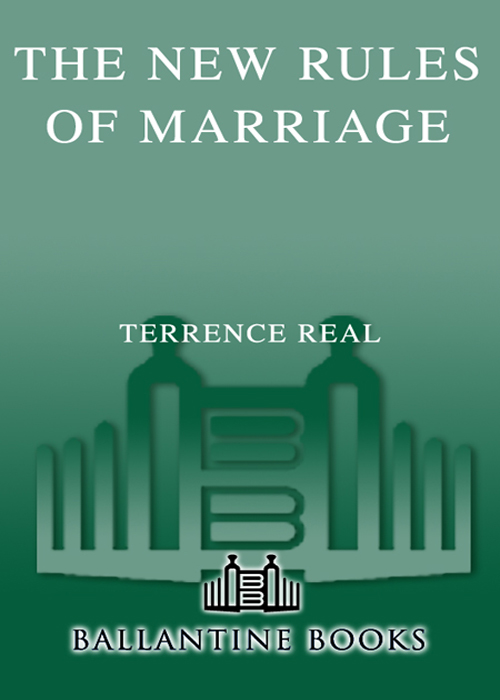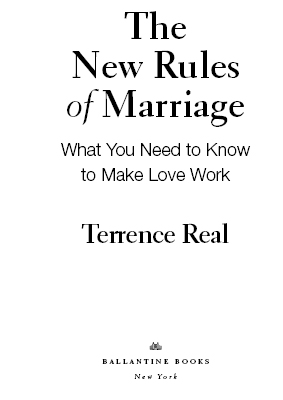To the gleeful, enduring spirit of Michela Harriman.
And to her family, who have cherished and who are cherished so profoundly.
Introduction
The New Rules of Marriage provides operating instructions for twenty-first century relationships. It walks you, step by step, through the fundamental skills of getting, giving, and having, teaching you how to get what youre after in your relationship, how to give your partner what he needs from you, and how to sustain and enjoy the closeness that healthy getting and giving brings.
Why do todays relationships need a new rule book? Because we are in a time of great change. The roles of men and women have dramatically shifted, and so have our expectations about relationships. We have never wanted more from one anothermore passion, more support, more connection. But our new desires have not been matched by a corresponding new set of skills, and for most of us, whatever we learned growing up about relationships is simply not sophisticated enough to deliver all that we hope for. Am I saying that we now need to be actively schooled if we want to have a satisfying relationship? Yes. That is exactly what Im saying.
As children, most of us were taught how to read and write, but precious little about how to conduct ourselves in the one area that means the most. We dont expect someone to step into a car for the first time and drive without training. And yet this is precisely what we expect of ourselves interpersonallyas if handling an automobile were a more complicated task than keeping your relationship on course. Relationships might have been that simple back in simpler times, but theyre certainly not that simple now. And the unfortunate results of our nave inattention clog our roadways with wreckage. Bad wrecksin the form of rampant divorce. Limping wrecksin the form of marriages that survive, but not very happily. And functional heapsin the form of banged-up relationships that run well enough but that could be a lot more satisfying.
Fortunately, you can do better than thismuch better. You can assert your wants and needs in ways that maximize the possibility of getting what youre after; you can bring your relationship back on track when it lurches off course; and, most of all, you can cherish and enjoy each other, building on each others strengths just as you did at the start. You can do all of these things. You can do them consistently. And you can do them well.
But you must learn how.
How This Book Came to Be
While I have had the privilege of practicing and teaching couples and family therapy for close to three decades, the evolution of The New Rules of Marriage began in 1997 with the publication of my first book, I Dont Want to Talk About It: Overcoming the Secret Legacy of Male Depression. At that time depression was widely considered a womans disease, so much so that I Dont Want to Talk About It was the first book ever written about the condition of male depression, even though it affects millions of men and their families. The book struck a chord, and I began getting calls from around the country. Some of the calls were from men but most were from womendesperate women whod already dragged their husbands to two, four, or even six couples therapies, all to no avail. Reading about the highly unusual therapy techniques described in I Dont Want to Talk About It sparked a last glimmer of hope. Did I know someone in their area, these callers asked, who worked in the manner shown in the book? In 2002 I followed I Dont Want to Talk About It with my first book on couples, How Can I Get Through to You?: Closing the Intimacy Gap Between Men and Women, and the number of calls increased.
At first, with regret, my answer to these urgent inquiries was no. I could not recommend someone in their area whod been trained in this model. I directed the callers, as best I could, to local resources. But after a year or so of such frustrating nos, it occurred to me one day to ask if the couples might be willing to come to Boston to work with me. Many were, and what quickly evolved was a couples intensive in which the partners and I agreed to work for two solid days, at the end of which time a determination would be made that they were either back on track or else filing for a divorce.
The success rate of these intensives was surprising. Easily nine out of ten couples renewed their relationships. I dont claim that these interventions fixed those relationships, but they did succeed in pulling the couples back from the edge of marital self-destruction. The therapeutic techniques that evolved from the challenge of these encounters were unusually quick, powerful, and very different from common practice.
Wanting to make this unconventional way of working with couples more widely available, I formed, with the help of wonderful colleagues, The Relationship Empowerment Institute for the purpose of training therapists in the new model. And Im delighted to say that, so far, hundreds of clinicians from around the country have come to Boston to train with us. At the same time, public media were getting wind of my couples intensives and began covering them. Most dramatically, the television show 20/20 came to my office one crisp New England spring morning with a couple I had never met who were on the verge of divorce. The cameras rolled and the couple and I had five hours to save their marriage. We did.
The professional training we offered at the Institute made it clear that the techniques I had been using could be articulated and taught to other clinicians. The next question was whether we could devise a curriculum, a process, that would enable a group of ordinary men and women to stimulate in one another something akin to the accelerated learning that occurred in the two-day intensives. With help and encouragement from my colleagues at the Institute, I created a three-day Relationship Skills Workshop in an attempt to answer that question. And the answer has been a resounding yes. Although the Workshop was not designed exclusively for couples in dire straits, many such couples claim to have found unexpected new hope, while couples along the whole spectrumfrom those in crisis to basically healthy couples hoping to become betterclaim that the experience of the workshop changed their lives.
The next question seemed clear. Could a manual be created that would walk a reader through a process akin to the three-day Skills Workshop? Could someone without professional coaching, either singly or with a partner, take in the information and begin the practices we taught in our groups? And the answer to that, as well, is a resounding yes.
That manual is in your hands.
How to Use This Book
Becoming relationally fit is just like becoming physically fit. Understanding how to achieve the goal is essential, but the best results come from the doing. You will find exercises throughout this book, some in the body of a chapter, others in separate practice sections following the chapters. These exercises are designed to guide you through three steps:
1. Assessing some aspect of yourself or your relationship
2. Envisioning with clarity the changes youd like to see
3. Beginning your practice of a new technique
I encourage you to do the exercises and to practice the skills presented in this book. Id like you to use the book as a guide through a processthe process of beginning to master the art of having a great relationship. Think of it as your own private tutorial.









